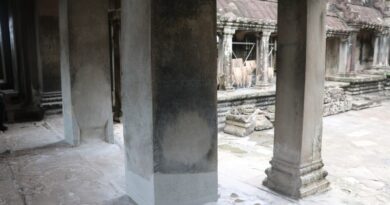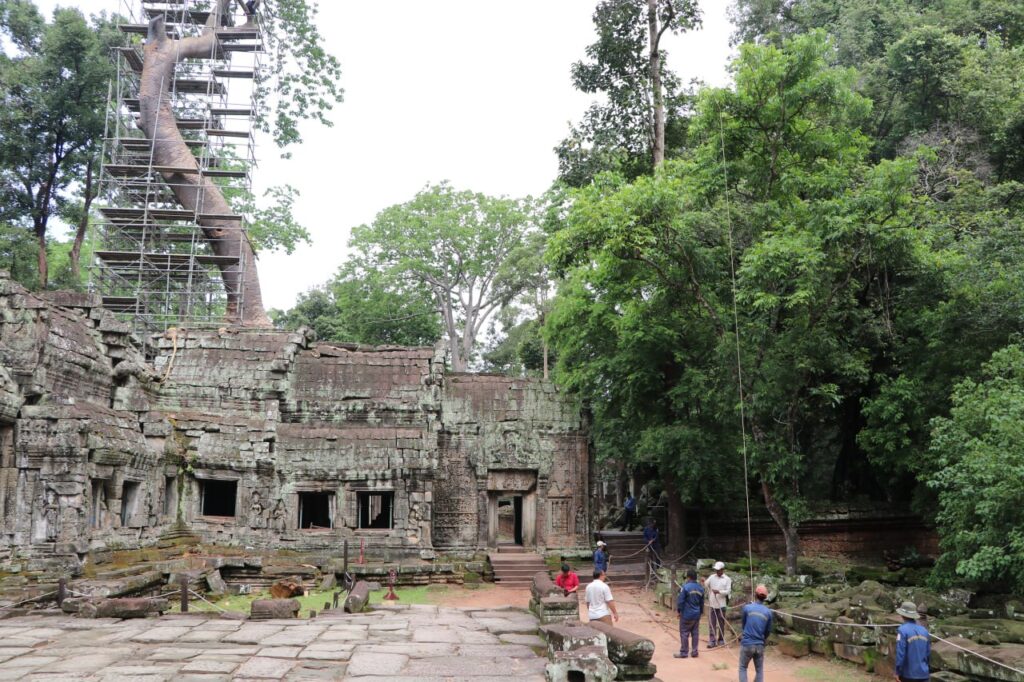ក្រុមការងារព្រៃឈើ នៃនាយកដ្ឋានគ្រប់គ្រងទឹក ព្រៃឈើ និងហេដ្ឋារចនាសម្ពន្ធ នៃអាជ្ញាធរជាតិអប្សរា កំពុងកាត់ក្រីមែក និងព្យាបាលដើមនិងឫសដើមស្ពង់ចំណាស់មួយដើម នៅជ្រុងខាងកើត ប្រាសាទតាព្រហ្ម។
លោក គង់ សុវណ្ណារិទ្ធ មន្រ្តីបច្ចេកទេសនៃនាយកដ្ឋានគ្រប់គ្រងទឹក ព្រៃឈើ និងហេដ្ឋារចនាសម្ពន្ធ បានលើកឡើងថា ដើមស្ពង់ចំណាស់ដែលក្រុមការងារលោកកំពុងកាត់ក្រី និងព្យាបាលនេះ មានសភាព ទ្រុឌទ្រោម និងត្រូវការការថែទាំ ព្យាបាល ដើម្បីទប់ស្កាត់ហានិភ័យ។ លោកបន្តថា ប្រសិនកង្វះខាតការ ថែទាំដិតដល់ ដើមឈើនេះអាចនឹងប្រឈមឆាប់ងាប់ និងបង្កគ្រោះថ្នាក់ដល់ប្រាសាទដូចគ្នា ព្រោះតួដើម និងឫសរបស់វាដុះជាប់យ៉ាងជិតស្និទ្ធជាមួយប្រាសាទ។ បន្ថែមពីនេះ ក៏អាចនឹងបាត់បង់សោភ័ណភាព ដែលទីតាំងនេះជាកន្លែងទាក់ទាញទេសចរ ដែលតែងឈរថតជានិច្ចនៅពេលបានមកដល់។
ក្រៅពីប្រយោជន៍ដូចជម្រាបខាងលើហើយ ព្រៃឈើក្នុងតំបន់រមណីយដ្ឋានអង្គរ ក៏ជារបាំងសម្រាប់ ការពារខ្យល់បាំងប្រាសាទ ជាម្លប់ និងជាសោភ័ណភាពទាក់ទាញទេសចរមួយផ្នែកធំផងដែរ។ តួយ៉ាង ដើមស្ពង់ដែលកំពុងព្យាបាលខាងលើ គឺកម្រត្រូវបានទេសចរមើលរំលងណាស់។
ចំពោះការព្យាបាល និងថែទាំ ក្រុមការងារព្រៃឈើបានដំឡើងរន្ទាឡើងកាត់មែកផ្នែកខាងចុង ដែលពុកផុយ ចំណែកនៅផ្នែកឫស គេបានចាំងនិងចោះសាច់ស្អុយឬពុកផុយចេញ បន្ទាប់មកគេព្យាបាល វាដោយប្រើជ័រទឹកលាយជាមួយខ្លាញ់គោ និងដីដំបូកបិទផ្ចិតរន្ធ។ ធ្វើដូច្នេះ គេអាចទប់ស្កាត់ ការពុកផុយ បន្តទៀត និងអាចធ្វើអោយសាច់ដើមឈើដុះគ្របឡើងវិញផងដែរ។ នេះជាការលើកឡើង របស់លោក គង់ សុវណ្ណារិទ្ធ ដែលធ្វើការផ្នែកកាត់ក្រីមែកឈើ និងព្យាបាលដើមឈើ ជាង១០ឆ្នាំមកហើយ។
គ្រឹះប្រាសាទនៅតំបន់រមណីយដ្ឋានអង្គរ មានទំនាក់ទំនងខ្លាំងជាមួយទឹកក្រោមដី។ ហើយតំបន់ដែលមាន ទឹកក្រោមដីច្រើន ជាតំបន់ដែលសម្បូរដើមឈើដូចគ្នា។ ដូច្នេះហើយ ទើបការអភិរក្សប្រាសាទនៅ តំបន់រមណីយដ្ឋានអង្គរ ក៏ត្រូវការចាំបាច់នូវដើមឈើ និងទឹកដូចគ្នា។ លោក សុវណ្ណារិទ្ធ បន្ថែមថា៖« ប្រាសាទត្រូវការសំខាន់ប្រព័ន្ធទឹកក្រោមដី ហើយដើមឈើមានមុខងារសំខាន់ក្នុងតំបន់ឧទ្យានអង្គរដែល ជួយទាក់ទាញទឹកភ្លៀង ទប់ទឹកភ្លៀង និងជួយទឹកជ្រាបក្រោមដីល្អបំផុត ធៀបនឹងតំបន់ទីវាល តំបន់មាន ដើមឈើ មានទឹកយូរជាង មិនងាយខ្សោះទឹកដូចនៅតំបន់ទីវាលទេ»។
គួរបញ្ជាក់ថា ក្រៅពីតំបន់ប្រាសាទតាព្រហ្ម កន្លងមក ក្រុមការងារព្រៃឈើ ក៏បានព្យាបាលដើមឈើធំៗ នៅតាមប្រាសាទមួយចំនួនទៀត ដូចជាប្រាសាទបាយ័ន តាកែវ ព្រះខ័ន និងតាមដងផ្លូវវង់តូចវង់ធំ ក្នុងរមណីយដ្ឋានអង្គរ។ អ្នកជំនាញព្រៃឈើ លោក សុវណ្ណារិទ្ធ ក៏សំណូមពរដល់ភ្ញៀវទេសចរមានការ ប្រុងប្រយ័ត្នកំឡុងពេលដើរតាមប្រាសាទ និងមានដើមឈើធំៗពិសេសនៅរដូវភ្លៀងនេះ និងសូមអោយ ពួកគេកុំយកដៃកេះ និងបកសំបកដើមឈើ ដែលការណ៍នេះអាចបង្កអោយដើមឈើទាំងនោះងាយ មានជំងឺ។ល៕
អត្ថបទ៖ នាង សំណាង
រូបភាព៖ យី សុថា
The forestry team is pruning and treating the old Spung tree (Tetrameles nudiflora) at Ta Prohm
The forestry team of the Department of Water, Forestry and Infrastructure Management of the APSARA National Authority is pruning and treating the old Spung tree and its root in the eastern corner of Ta Prohm.
Mr. Kong Sovannarith, Technical Officer of the Department of Water, Forestry and Infrastructure Management, said that the old Spung tree that his team is pruning and treating is in a dilapidated condition and needs special care to prevent risks. He added that if the lack of intensive care the tree may face early death and harm to the temple as well because its trunk and roots grow close to the temple. In addition, there may be a loss of beauty, which is a tourist attraction that always takes pictures of this tree when they arrive.
In addition to the benefits mentioned above, the forest in the Angkor area is also a barrier to protecting the temple from strong wind, providing shade, and the beauty attracting a large part of tourists.
For treatment and care, the forestry team installed a scaffold to cut through the rotten end of the branch, while the root part was glazed and the rotten flesh was pierced and then treated with resin mixed with cow dung and soil. In this way, they can prevent further decay and can regenerate the flesh of the tree. This is the statement of Mr. Kong Sovannarith, who has been working in pruning and tree treatment for more than 10 years.
The foundations of temples in the Angkor area are strongly associated with groundwater. And areas with more groundwater are areas with lots of trees. That is why conserving temples in the Angkor area also requires maintaining trees and water. Mr. Sovannarith added: “Temples need an important groundwater system, and trees play an important role in Angkor Park, which attracts rainwater, retains rainwater, and helps best groundwater permeability compared to open field areas”.
It should be noted that in addition to the Ta Prohm temple area, the forestry team also treated large trees in some temples such as Bayon, Takeo, Preah Khan, and Small and Grand circuits in the Angkor site. Mr. Sovannarith also urges tourists to be careful during the walk through the temple and the giant trees, especially in the rainy season, and not to use their hands to trigger and peel the trees, which can cause the trees to get the disease, etc.
Article: Neang Samnang
Photos: Yi Sotha
Share:
Our Latest News

អាជ្ញាធរជាតិអប្សរាកំពុងអភិរក្ស និងជួសជុលជើងសសរនៅរួតបាកានប្រាសាទអង្គរវត្ត- APSARA National Authority is restoring pillars at the Bakan Tower, Angkor Wat- 05 June 2025
ក្រុមការងារនាយកដ្ឋានអភិរក្សប្រាសាទ និងបុរាណវិទ្យា នៃអាជ្ញាធរជាតិអប្សរា កំពុងអភិរក្ស និងជួសជុលជើងសសរនៅរួតបាកានប្រាសាទអង្គរ ដែលជើងសសរមួយចំនួនមានការពុកផុយ។




